Sivantos WL002ITE ITE Hearing Aid User Manual USer Manual
Sivantos GmbH ITE Hearing Aid USer Manual
Sivantos >
USer Manual

Pure 700 CIC,
Pure 500 CIC
User Guide

Dear customer,
Congratulations! You have selected a hearing instrument
from Siemens. This hearing instrument was individually
manufactures according to the shape of your ears and is
fitted specially to your personal hearing profile.
These instructions, together with guidance from your
Hearing Care Professional, will help you understand how
your new hearing instrument works.
If you have any further questions, please contact your
Hearing Care Professional.
1
Introduction
3

Your Pure CIC hearing instrument 6
Intended use 7
General notes on safety 8
Handling batteries 9
Low battery indicator
- 9
Inserting the battery 1
- 0
Removing the battery 1
- 1
Inserting hearing instruments 12
Removing hearing instruments 13
Turning your hearing instrument on and off 14
Using the battery compartment 1
- 4
Using the program button (optional) 1
- 4
Power-on delay
- 15
Changing the hearing program 16
How to select programs 1
- 6
Using the program button (optional) 1
- 6
Using the remote control (optional) 1
- 7
e2e wireless 2.0 (optional) 18
Maintenance and care 19
Contents
2
3
4
5
6
7
8
9
10
11
12
4

Contents 2
Accessories 21
Remote control 2
- 1
Tek wireless enhancement 2
- 2
Troubleshooting tips 24
Technical information 26
Your hearing instrument configuration 28
Disposal information 29
13
14
15
16
17
5

Feature
1 Vent
2 Battery compartment
3 Program button (optional)
4 Microphone
5 Removal cord (optional)
Your hearing Instrument is individually manufactured
according to the shape of your ear canals.
Each hearing instrument can be identified by the serial
number located on the outside of the instrument.
If the number is written in red, the hearing instrument is
for the right ear.
If the number is written in blue, the hearing instrument
is for the left ear.
Pure 700 CIC / Pure 500 CIC
(battery type: 10)
2
5
1
4
Your Pure CIC hearing instrument
3
3
6
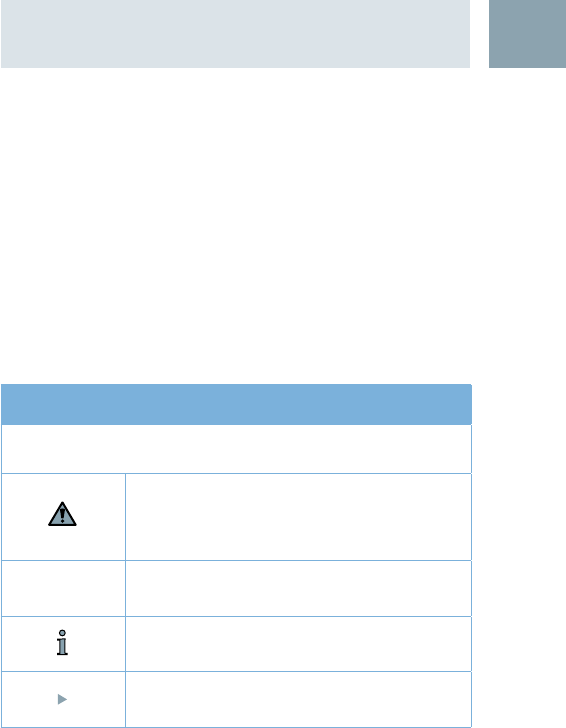
Intended use 4
Hearing instruments are intended to improve the hearing
of hearing impaired persons. Diagnosis and prescription
of a hearing instrument must be performed by hearing
health specialists, e.g. ENT doctors, audiologists or
acousticians.
Read and follow the instructions of this user guide to
avoid injuries or damage to the hearing instrument.
Symbols:
Be aware of information marked with the warning symbol
WARNING, CAUTION or NOTICE!
WARNING points out a situation that could
lead to serious injuries,
CAUTION indicates a situation that could
lead to minor and moderate injuries.
NOTICE NOTICE indicates possible property
damage.
Advice and tips on how to handle your
hearing instrument better.
Instruction. Indicates that something has to
be done.
7

General notes on safety
5
NOTICE for batteries
Turn your hearing instrument off when not in use to
preserve the battery.
Leaking batteries damage the instrument. Remove
batteries when the instrument is not in use for a pro-
longed period of time.
NOTICE
Your hearing instrument is sensitive to extreme heat,
high humidity, strong magnetic fields (> 0.1T),
X-rays and mechanical stress.
Do not expose your hearing instrument to extreme
temperature or high humidity. Do not leave it in
direct sunlight. Do not wear it in the shower or when
you apply make-up, perfume or aftershave, hairspray
or suntan lotion.
Do not wear your hearing instrument when you are
exposed to short-waves, a strong magnetic field, a
high frequency field or X-rays.
WARNING
Risk in explosive environments, e.g. mining areas!
Don't use your hearing instruments (and remote
control) in areas where there is a danger of
explosions.
In some countries restrictions for the usage of wire-
less equipment exists.
Refer to local authorities for further information.
8
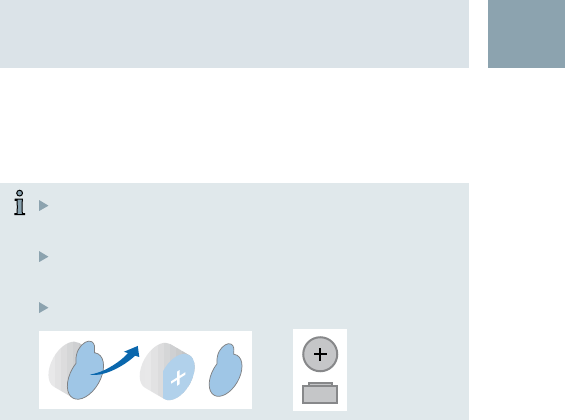
Handling batteries 6
10
Remove the tab on your battery only when you are
ready to use it.
The positive (+) side of the battery is always the
smooth side.
Always keep spare batteries with you.
Low battery indicator
Your Hearing Care Professional can program your hearing
instrument to inform you when the battery is nearly
empty. If you hear an intermittent series of beeps or expe-
rience low amplification power, replace the battery.
original size
9
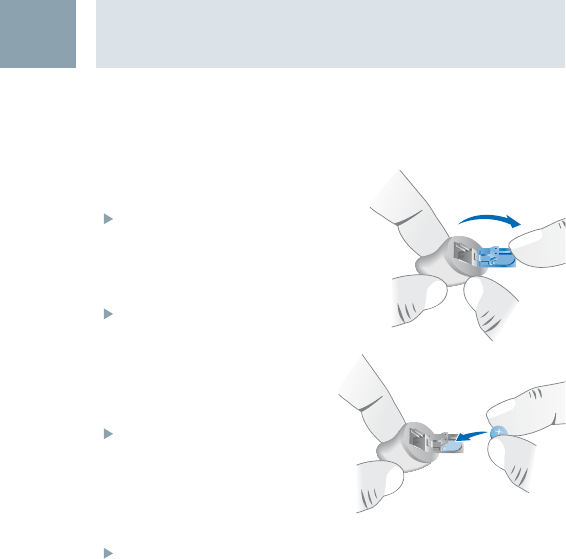
Inserting the battery
Open the battery compart-
ment completely using your
fingernail as shown in the
illustration.
Insert the proper size battery
so that the "+" symbol on
the battery aligns with the
"+" marked on the battery
compartment.
Close the battery com-
partment by gently pres-
sing the bottom of the
door upward with your
finger tip.
Do not force the door shut. If it does not close easily,
check to see if the battery was inserted properly.
When the battery door is completely closed, your
hearing instrument is ready for use.
6Handling of batteries
10

6
Handling of batteries
Removing the battery
Open the battery compartment completely.
Lightly push the battery out with your finger or a
pencil.
Do not throw used batteries into household trash.
Return them to your Hearing Care Professional for
environmentally correct disposal.
WARNING
Choking hazard posed by small parts.
Keep hearing instruments, batteries and acces -
sories out of children's reach.
If swallowed consult a physician or a hospital
X
immediately.
If infants, small children or mentally disabled
X
persons need to wear hearing instruments ensure
adequate supervision.
11
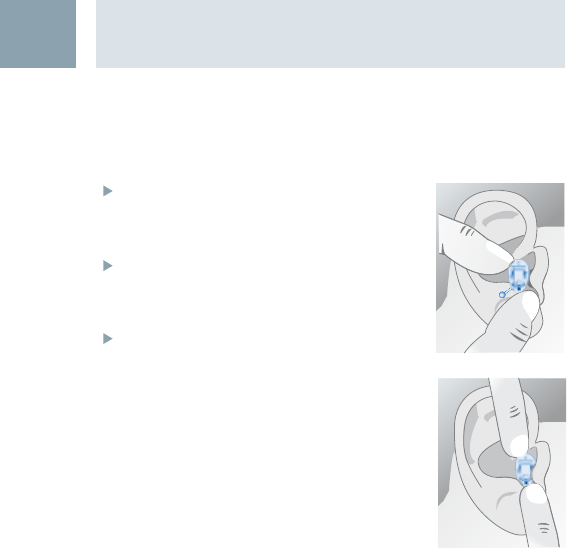
Inserting hearing instruments
7
Hold the hearing instrument between
your thumb and index finger and in-
sert it into the ear canal.
Gently work it into its proper position
by slightly twisting until it is firmly
seated.
Lightly press inward for a secure and
comfortable fit.
You may find it helpful to pull your ear
slightly upward or to the back. Once
inserted, you should be able to feel
if the hearing instrument is correctly
positioned.
12
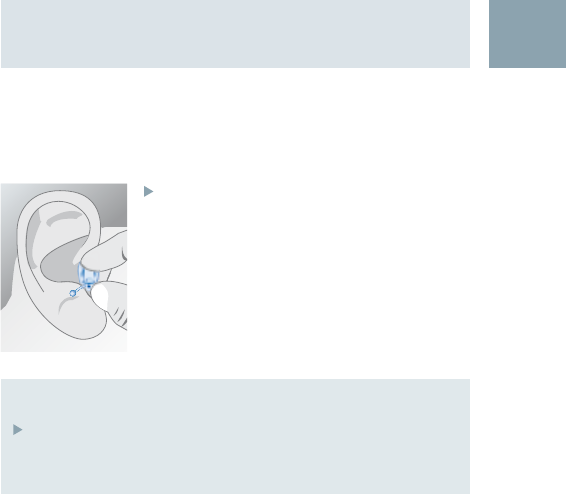
8
Removing hearing instruments
Push lightly on the back of your ear to
help loosen the hearing instrument or
pull gently on your ear.
Then your hearing instrument can be
removed by using the small removal
cord.
NOTICE
Never pull on the battery compartment door to remo-
ve the hearing instrument, as this could cause damage
to your hearing instrument.
13

Turning your hearing instrument on and off
9
Using the battery compartment
Turn on:
Insert the battery and close the compartment door
completely. Your Pure CIC hearing instrument turns on
automatically.
Turn off:
Open the compartment completely.
Using the program button (optional)
Your Hearing Care Professional can program your hearing
instrument to be turned on and off using the program
button.
Turn on:
Press and hold the program button for approximately
2 seconds.
Turn off:
Press and hold the program button for approximately
2 seconds.
If you turn your hearing instrument off this way you
must wait approximately 10 seconds before your can
turn it on.
14

9
Turning your hearing instrument on and off
You can also use the remote control to turn your hea-
ring instrument on and off.
Power-on delay
Your hearing instrument is equipped with a "power-on de-
lay" feature which can be activated by your Hearing Care
Professional. This allows you to turn the hearing instru-
ment on with an automatic delay of 6, 12 or 18 seconds,
so that you may insert the hearing instrument into your
ear without experiencing unpleasant feedback (whistling).
15
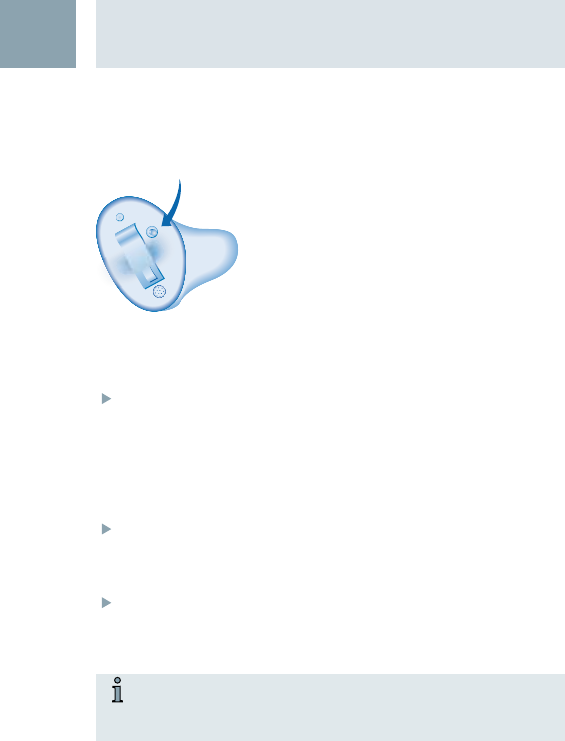
How to select programs
Your Pure CIC hearing instrument
offers up to 5 hearing programs for
specific listening environments.
10 Changing the hearing program
Using the program button (optional)
Select a program using the program button.
Each time you press the program button, your hearing
instrument switches to the next program, confirming each
change with an acoustic signal.
Example
Turn your hearing instrument on.
It is automatically in program 1. You want to change to
program 2.
Press the program button once.
You hear an acoustic signal. You are now in program 2.
Your Hearing Care Professional can activate or deacti-
vate acoustic signals.
16

You can also use the remote control to change the
hearing program if your Pure CIC hearing instruments
are equipped with e2e wireless 2.0.
10
Changing the hearing program
If you are wearing two hearing instruments, the hearing
program will be changed on both instruments simultane-
ously if your Pure CIC hearing instruments are equipped
with e2e wireless 2.0.
Your Hearing Care Professional can write down the perso-
nal program configuration of your hearing instrument on
page 28.
Using the remote control (optional)
17

e2e wireless 2.0 (optional)
11
Your Pure CIC hearing instrument is equipped with wire-
less technology.
Advantages of the wireless functionality
Automatically adjusts both hearing instruments simul-
taneously to different listening situations.
Allows use of accessories, e.g. Tek.
Provides synchronization of the settings in the system.
If you change the program on one hearing instrument,
the other hearing instrument is automatically adjusted.
Your Hearing Care Professional can activate or deactivate
the wireless functionality of your hearing instruments.
For further information contact your Hearing Care Profes-
sional.
The performance of wireless may be affected by
electromagnetic interference – e.g. from a computer
monitor or halogen lamp system controlled by a
switching power supply.
Move away from the source of interference if you
experience difficulty.
18

Maintenance and care 12
NOTICE
Do not put the hearing instrument in
water.
Your hearing instrument is a highly sensitive system. Pro-
per care and handling will ensure the best possible perfor-
mance.
If soreness or skin irritation develops in the ear, disconti-
nue wearing your hearing instrument, and bring it to your
Hearing Care Professional. Minor fit adjustments and poli-
shing can often correct this condition. If soreness persists,
discontinue wearing the hearing instrument and see your
physician.
If excessive earwax accumulates when wearing your
hearing instrument, consult your Hearing Care Professio-
nal.
19

12 Maintenance and care
Your hearing instrument may be equipped with a sieve, re-
cess or guard on the sound outlet to prevent earwax from
entering the hearing instrument.
Clean your hearing instrument daily with a soft and dry
tissue to prevent damage to the hearing instrument and
to avoid health problems.
Place your hearing instrument in a "dry aid kit" with a
special moisture-attracting capsule overnight.
Occasionally bring your hearing instrument to your Hea-
ring Care Professional to change the wax guard,
clean the venting channel, microphone and sound out-
lets, and for general system maintenance.
Ask your Hearing Care Professional for special care sets
and further information on how to keep your hearing
instrument in good condition.
20

Remote control
The wireless function of your Pure CIC hearing instrument
allows you to use a remote control to change the pro-
gram, volume or to turn your hearing instrument on and
off.
For further information about the remote control, contact
your Hearing Care Professional or refer to the remote con-
trol user guide.
In the event your hearing instrument can be X
controlled by another person's remote control unit,
return your remote control and hearing instrument to
the Hearing Care Professional for adjustment.
Accessories
(optional) 13
21
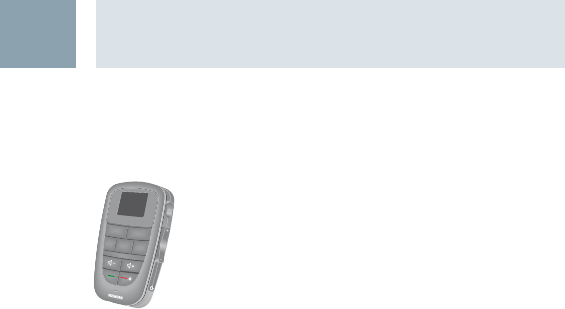
Accessories
(optional)
13
Tek wireless enhancement
Your hearing instruments together with the Tek
Connect remote control will allow you to con-
nect your hearing instruments to the growing
world of technology. Via a special Bluetooth
connection it is possible to receive audio signals
from your mobile, your television or your mp3-player.
For detailed information and instructions refer to the Tek
user guide or ask your Hearing Care Professional.
P1 P2
MICRORIC TEK
P5
P4
P3
22

23

Problem Cause Possible Solution
Sound is weak
or no sound
Weak or dead battery
Instrument not turned on
Instrument clogged
Volume too low
Insert new standard battery
Close battery door completely or press and hold the pro-
gram button for approximately 2 seconds
Clean instrument
Increase volume (only with optional remote control)
Instrument emits
whistling sound
Improper seating in ear
Clogged with wax or excessive wax in ears
Try reinserting instrument until it fits securely
Clean instrument or contact your Hearing Care Professional
Sound is
distorted
Volume too high
Weak battery
Clogged with wax
Lower volume (only with optional remote control)
Replace battery
Exchange or have your wax guard changed
Instrument emits
signal tones
Battery compartment not completely closed
Weak battery
Gently close battery compartment completely
Replace battery
Instrument
does not work
Instrument is not turned on
Battery compartment not completely closed
Dead battery
Battery polarity reversed
Power-on delay is active
Turn instrument on
Gently close battery compartment completely
Insert new standard battery
Make sure battery is inserted correctly
Wait 18 seconds and check again
Your Pure CIC hearing instrument is an extremely reliable
device. Should a problem occur, it can usually be corrected
quickly. Use these troubleshooting tips to resolve simple
issues.
Troubleshooting tips
14
24

Problem Cause Possible Solution
Sound is weak
or no sound
Weak or dead battery
Instrument not turned on
Instrument clogged
Volume too low
Insert new standard battery
Close battery door completely or press and hold the pro-
gram button for approximately 2 seconds
Clean instrument
Increase volume (only with optional remote control)
Instrument emits
whistling sound
Improper seating in ear
Clogged with wax or excessive wax in ears
Try reinserting instrument until it fits securely
Clean instrument or contact your Hearing Care Professional
Sound is
distorted
Volume too high
Weak battery
Clogged with wax
Lower volume (only with optional remote control)
Replace battery
Exchange or have your wax guard changed
Instrument emits
signal tones
Battery compartment not completely closed
Weak battery
Gently close battery compartment completely
Replace battery
Instrument
does not work
Instrument is not turned on
Battery compartment not completely closed
Dead battery
Battery polarity reversed
Power-on delay is active
Turn instrument on
Gently close battery compartment completely
Insert new standard battery
Make sure battery is inserted correctly
Wait 18 seconds and check again
If you still encounter problems after trying these sugge-
stions, consult your Hearing Care Professional.
14
25

15 Technical information
Operating frequencies: Fc=3.28 MHz
This Class B digital apparatus complies with Canadian ICES-
003.
Changes or modifications not expressly approved by the
party responsible for compliance could void the users aut-
hority to operate the equipment.
Siemens Pure 500 CIC, Pure 700 CIC
This device complies with Part 15 of the FCC Rules and
with RSS-210 of Industry Canady.
Operation is subject to the following conditions:
(1) this device may not cause harmful interference, and
(2) this device must accept any interference received,
including interference that may cause undesired
operation.
Siemens Pure 500 CIC WL, Pure 700 CIC WL
FCC ID; SGI-WL002ITE
IC: 267AB-WL002
This device complies with Part 15 of the FCC Rules and
with RSS-210 of Industry Canady.
Operation is subject to the following conditions:
(1) this device may not cause harmful interference, and
(2) this device must accept any interference received,
including interference that may cause undesired
operation.
26

15
Technical information
This equipment has been tested and found to comply with
the limits for a Class B digital device, pursuant to Part 15
of the FCC Rules. These limits are designed to provide
reasonable protection against harmful interference in a re-
sidential installation. This equipment generates, uses and
can radiate radio frequency energy and, if not installed
and used in accordance with the instructions, may cause
harmful interference to radio communications. However,
there is no guarantee that interference will not occur in a
particular installation. If this equipment does cause harm-
ful interference to radio or television reception, which can
be determined by turning the equipment off and on, the
user is encouraged to try to correct the interference by
one or more of the following measures:
Reorient or relocate the receiving antenna.
Increase the separation between the equipment and
receiver.
Connect the equipment into an outlet on a circuit diffe-
rent from that to which the receiver is connected.
Consult the dealer or an experienced radio/TV technician
for help.
27

Hearing instrument
LEFT RIGHT
CIC Model CIC
Serial number
10 Battery 10
yes no Power on delay yes no
yes no Push button yes no
yes no e2e wireless 2.0 yes no
Signal tones
on off Low battery warning on off
on off Volume control limit on off
on off Volume control change on off
Hearing
program Description of the hearing program
1
2
3
4
5
Remote control
Serial
number
Your hearing instrument configuration
16
28
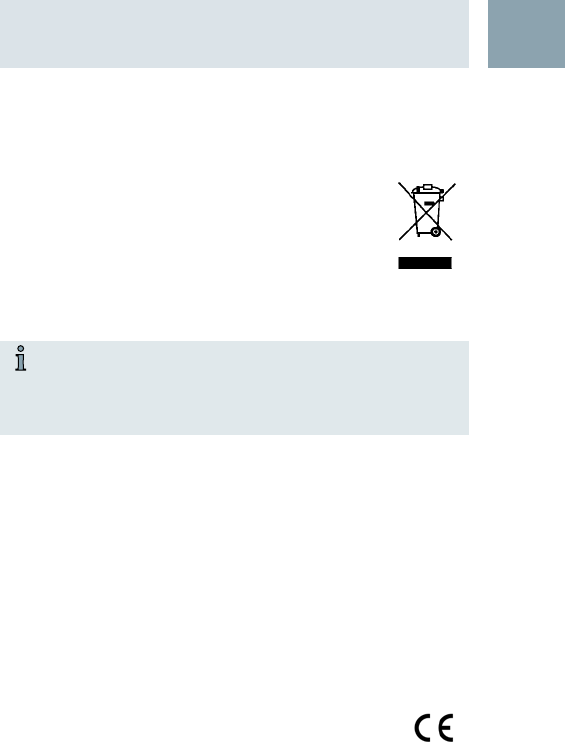
Disposal information 17
Within the European Union, the marked equip-
ment is covered by "Directive 2002/96/EC of
the European Parliament and of the Council of
27 January 2003 on waste electrical and elec-
tronical equipment."
Amended by "Directive 2003/108/EC" (WEEE).
NOTE
Recycle your hearing instruments and batteries accor-
ding to national regulations.
For disposal within the EU please send devices to the
following address:
United Kingdom Malta Ireland
Siemens Charles de Giorgio LTD Howth Junction
Hearing Instruments 39-40 South Street Business Center
Newton Road Valetta CMR 01 Kilbarrack
Crawley RH109TT P.O. Box 374 5 Dublin
www.hearing-siemens.com
With the CE marking Siemens confirms compliance
with the European Directive 93/42/EEC concerning
medical devices. 0123
29

30

31

www.siemens.com /hearing
Siemens Audiologische Technik GmbH
Gebbertstrasse 125
91058 Erlangen
Germany
Phone +49 9131 308 0
© Siemens AG, 03.2008 · ANR
Document No. A91SAT-00356-99T1-7600
Order/Item No. 102 97 495
Printed in Germany